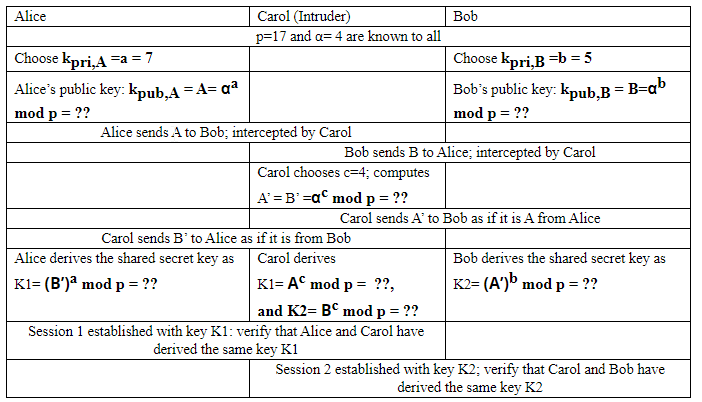Shared session key establishment using a Key Distribution Center (KDC). Using the following table, illustrate how Alice can initiate a secure session with Bob with the help of KDC. Here, KEKs are the long term key establishment keys used to transport the session keys across the network securely. Assume the encryption process to be as follows: Divide the key into two halves: LK and RK; Divide the plaintext into two halves: LT and RT; Then ciphertext= LC||RC where LC=LK XOR RT; and RC = RK XOR LT; where LC, RC, LT, and RT are each 4 bits; Plaintext and ciphertext are each 8 bits. For example, if plaintext=A7 (Hexa) and Key = 6D; then LC=6 ⊕ 7 = 0110 ⊕ 0111 = 0001 = 1 (Hexa); and RC = D ⊕ A = 1101 ⊕ 1010 = 0111 = 7 (Hexa); so Ciphertext = 17 (Hexa). To decryptt, it does the reverse operation: Given ciphertext of C=LC||RC, it finds plaintext T=LT||RT, by finding LT=RC ⊕ RK and RT = LC
**Please use the provided information**
-
Shared session key establishment using a Key Distribution Center (KDC). Using the following table, illustrate how Alice can initiate a secure session with Bob with the help of KDC. Here, KEKs are the long term key establishment keys used to transport the session keys across the network securely. Assume the encryption process to be as follows: Divide the key into two halves: LK and RK; Divide the plaintext into two halves: LT and RT; Then ciphertext= LC||RC where LC=LK XOR RT; and RC = RK XOR LT; where LC, RC, LT, and RT are each 4 bits; Plaintext and ciphertext are each 8 bits. For example, if plaintext=A7 (Hexa) and Key = 6D; then LC=6 ⊕ 7 = 0110 ⊕ 0111 = 0001 = 1 (Hexa); and RC = D ⊕ A = 1101 ⊕ 1010 = 0111 = 7 (Hexa); so Ciphertext = 17 (Hexa). To decryptt, it does the reverse operation: Given ciphertext of C=LC||RC, it finds plaintext T=LT||RT, by finding LT=RC ⊕ RK and RT = LC ⊕ LK. In the above example, LT = 7 ⊕D = 0111⊕1101=1010=A; RT=1 ⊕ 6 = 0001 ⊕ 0110 = 0111=7; So Plaintext=A7 (Hexa).
b. Alice and Bob now decide to use Diffie-Hellman Key Exchange (DHKE) (p. 343) with certificates. Both Alice and Bob agree on p=17 and α=4. Alice chooses a=5 and Bob chooses b=3. Answer the following.
-
- What is the public key generated by Alice?
- What is the public key generated by Bob?
- What is the computed shared key by Alice?
- What is the computed shared key by Bob?
c. Man-in-the-middle attack when Alice and Bob employ Diffie-Hellman key exchange. Here, Carol is the intruder. Compute and complete the unknown entries in the exchanges shown below.


Trending now
This is a popular solution!
Step by step
Solved in 5 steps with 5 images


